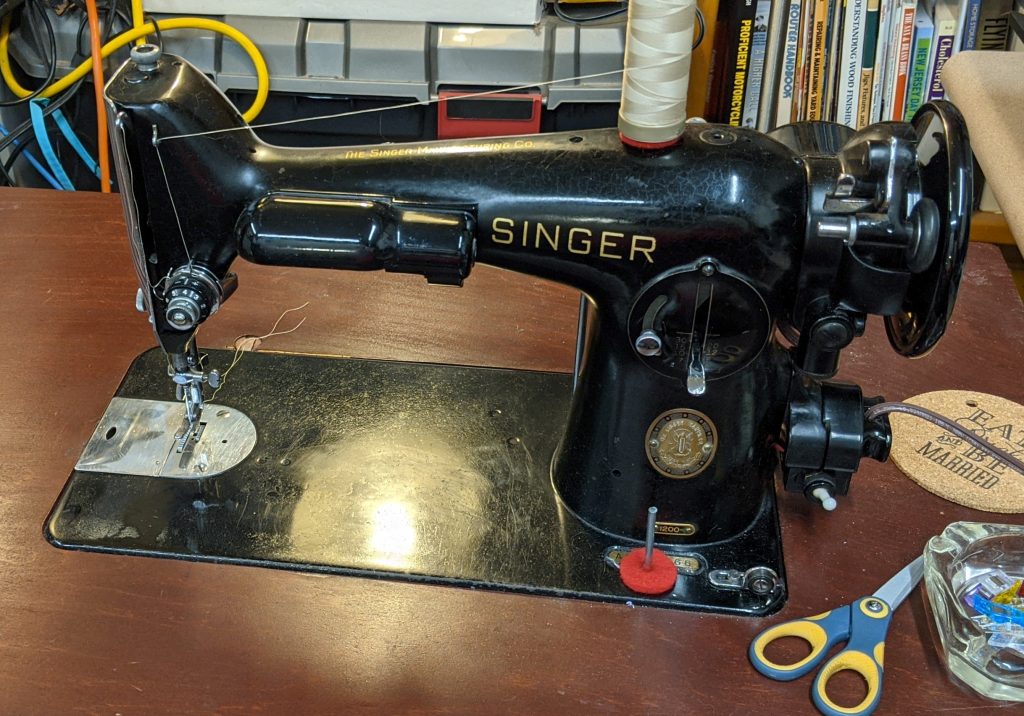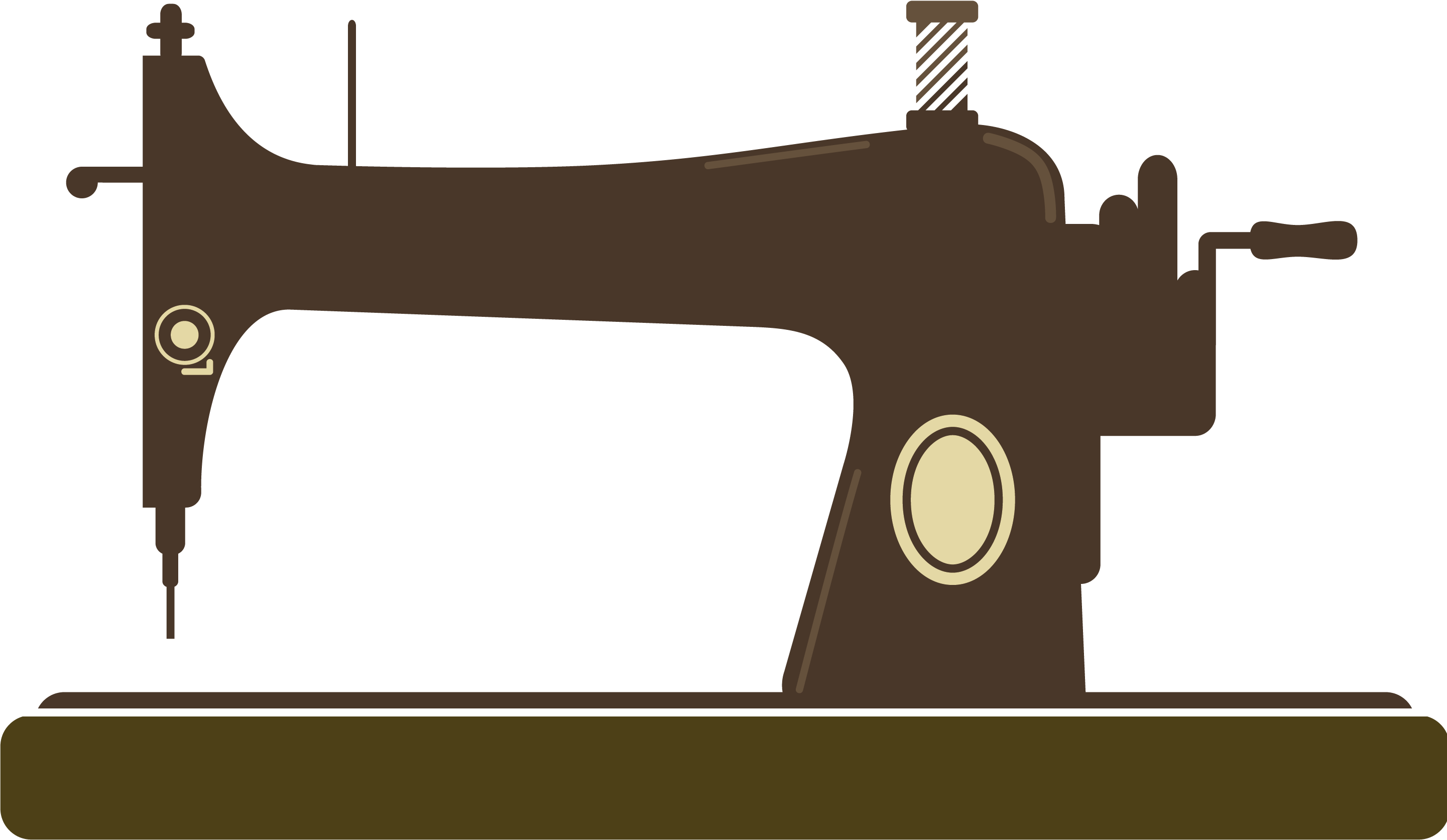It’s been about a year since I had my own “personal” Singer 201 in my arsenal. I gave my last personal one to my daughter in law Christine (and that machine is one of the finest stitching 201-2’s I’ve ever seen), when I moved on to using a Singer 1200-1. Now those in the know realize that a 1200 is really a 201-2 with a knee lift, but it IS placarded as a 1200, so I’m going to be a stickler for accuracy. My 1200 is also a fine machine, and I truly enjoyed the hours I spent sewing with her.

I’ve bought/sold/gifted a LOT of Singer 201-2 and 15-88/90/91 machines. Anyone in my family who wanted one, and I encouraged everyone to speak up, has one in their house. For the few who declined my offer, the offer still stands, just say the word, give me some time, and I’ll be more than happy to make it happen.

I’m one of those who believe strongly that the 201 based machines are the best domestic straight stitchers ever made, but alas, I had a genuine NEED for a much heavier duty, walking foot machine. So, with space being at a premium here in our very small house, my beloved 1200 had to go to a new home. She now lives with our good friend Brandi, where she is well loved and being well cared for. The reason for giving her up was simply that we have limited room, and the size of the 1200’s table (NOT a cabinet, because of the knee lift) made her impossible to keep with the much needed addition of the Sailrite Leatherwork walking foot machine. So, a day or so before the Sailrite arrived, the 1200 moved a few blocks over to Red and Brandi’s place.

Fast forward to the present day…

Lurking deep in my stash of vintage Singers was this refugee from Kilbowie, Scotland, a genuine 201K3. The “K” in the model number indicates the Kilbowie manufacturing plant, the “3” indicates the machine uses an external, belt drive motor. There were also -1 machines which had treadle power, -2 machines with used an attached “potted” motor and had a front mounted sewing light, and a -4 model which was a portable unit powered by a hand crank. Lest the reader think that a hand crank was a horrible way to go, there are many sewists today who still prefer a hand cranked machine Not many US made 201 series machines were in the -1, -3, or -4 configuration – at least not many that were delivered after the Rural Electrification Act of 1936. The vast majority of 201’s made at the Elizabeth, New Jersey plant were of the -2 variety, at least those that survive around here today. From what my friends on the other side of the pond, as well as those in Australia and New Zealand tell me, they rarely, if ever, see a -2 configured machine that was made in Kilbowie. Go figure…
I should mention that the -1 and -4 machines could easily, and affordably, be updated to the -3 standard, but I have yet to see one in the wild here in New Jersey.
Getting back to my 201K3…
When I was testing my new sewing machine maintenance fixture, I needed a full size subject of suitable wight. I have an abundance of 66 series machines, but they are very lightweight in comparison. There is a 15-91 in the house that needs some work, but in all honesty, I had just done a video on the 15-30 mechanism, and the -91 is very similar. Likewise, I have a 201-2 that’s lurking in a cabinet, but it’s buried and hard to access. I did have the 201K3, a nice, heavy, 201 series machine – not just a 201, but a -3 model, and there aren’t many videos of those on YouTube. It was time…
I bought the 201K3 15 or 16 months ago on Staten Island. I saw the machine listed on Facebook Marketplace for $40, and while that may sound like a total steal, you must also consider the toll is $16 for the Outerbridge Crossing (round trip) and another $3 for the Garden State Parkway, not to mention that my truck gets 11 MPG. Hey, it all adds up…
The 201K3 lingered in my garage, awaiting its turn for quite a while. In the meantime, some parts were “borrowed” to help other machines live again. Her motor, bobbin winder, lamp assembly, power block, and balance wheel all went to other machines with more pressing needs. Even her #40 cabinet went to help a beautiful singer 66-1 Red Eye. She was reduced to a mere shell of her previous glory.
That all changed on August 13th, 2021.

I installed her on the work fixture, made some quick measurements, and went to the garage to weld up the machinist jack which became the last part of my fixture project.

She then served as the test subject for what became a quick, 3 minute and 28 second video about the fixture. I no sooner finished editing the video when I realized that, of all the videos I have produced on Singer 201 subjects, I had never addressed the bottom end! The time had come to rectify that oversight.
Back to the shop, fire up the camera and the lights, kill the fans, start to sweat!
The resulting video covers the feed mechanism of the Singer 201 in more detail than most people would ever want, but at least I now have it documented. In the process, I have a full disassembled 201 bottom end on my hands, so what to do? Well, saying those parts were filthy is a gross understatement. There was no way I was going to put her back together covered in grime, so it was once again, time to strike while the iron was hot.
When I was putting her bottom end back together, it dawned on me that although Liz and I have a boatload of machines in our personal stash, only Liz had, at that time, a 201 that was ready to rock and roll. Her 201-2 is in a #42 art deco cabinet. I consider her machine to be HER machine. If I need to sew something, I’ll use something else. Just as we both have Buescher True Tone alto saxophones, MY 1929 is MINE, and HER 1927 is HERS – it’s a line I refuse to cross.

It became obvious to me while I was cleaning the 201K3 that I absolutely NEEDED to have a personal 201 again, but how? We don’t have room for another cabinet, and in my not very humble opinion a 201 is best in a cabinet or table.
Then it hit me like a ton of bricks.
The Sailrite and the 201 both have the same footprint! I wasn’t talking a 201-2, I was talking a 201K3 – a belted motor machine. That means, I don’t have to hang a motor on it at all, the 201 can “share” the Sailrite’s table and servo motor! Whichever machine is not in use can live in a carry case to protect it from dust and dirt (and in our house of 7 cats, cat hair!) Oh man! a servo powered 201! I’d seen video of guys going it, but nothing as elegant as my solution; except I still had yet to work out the details…
The Master Plan…
I knew that the 201 would fit in the opening of the table, and that the hinge spacing was the same. Fortunately, a lot of these things are like Lego, and the manufacturers don’t reinvent the wheel with every machine.
The question became: How to use the servo motor? The Leatherwork utilizes two belts and an intermediate pully system as the speed reduction, which makes perfect sense, it needs the addition torque for punching power. The 201 is graceful and built for speed! A stock 201-2 with its potted motor will run all day long at 1100 SPM (stitches per minute). The Sailrite Leatherwork is essentially their LS-1 with different feed dogs and the servo motor/table. Sailrite tells owners of the LS-1 that if they are going to use the servo motor, to turn it down to 25. For the LS-1 and Leatherwork, that makes perfect sense, they use oscillating hooks and running them at high speed is an invitation to break pieces… expensive pieces.

The 201, on the other hand, is a gear driven, full rotary hook, and is capable of MUCH higher sewing speeds. The question is, how to connect it without making any alterations to the table or the motor.
Once again, the answer was sewing machine Lego. While Sailrite sells their machines with an oversized balance wheel that uses their Posi-Pin system, the offer a cogged “normal” sized wheel that uses a standard stop motion clutch knob. Sewing machine Lego!
For $25 + shipping, one was ordered. I did a lot of reading of the Sailrite instruction manuals and determined that an LS-1 in my table with their large sized balacheel and no speed reduction requires a 42″ 3/8″ cogged belt with a .2″ pitch. Some measurements of the heights of the centerlines of the Leatherwork and 201 machines, followed by a little math where the difference in diameter of the balance wheels were taken into consideration, and I guesstimated that I would need a 40″ belt of the same width and pitch. Guess what I found on Amazon for $12?
The only issue to be resolved is the bobbin winder. I fabricobbled a bobbin winder out of parts salvaged from various Japanese 15 clones of the 1950’s and 60’s, and while it “works” I’m not happy with it. My intent is to procure a bobbin winder for a commercial machine, motorize it, and mount it on the far right side of the table. That way, it can be used for both the class 66 bobbins of the 201 and the class 15 of the Sailrite.
So that’s where we stand as of right now. More to come!




